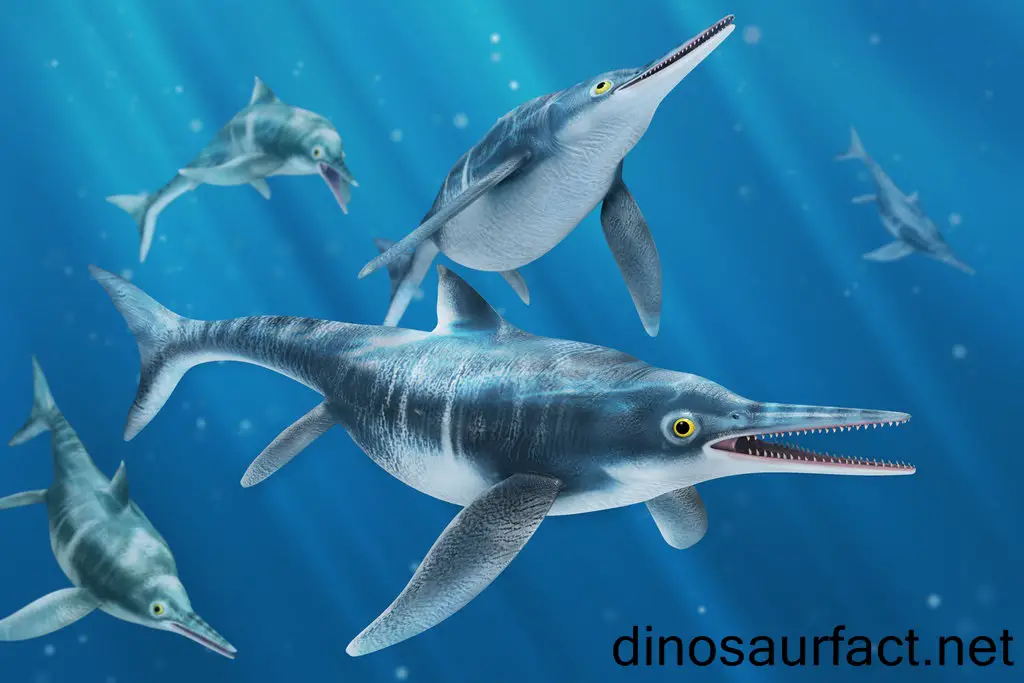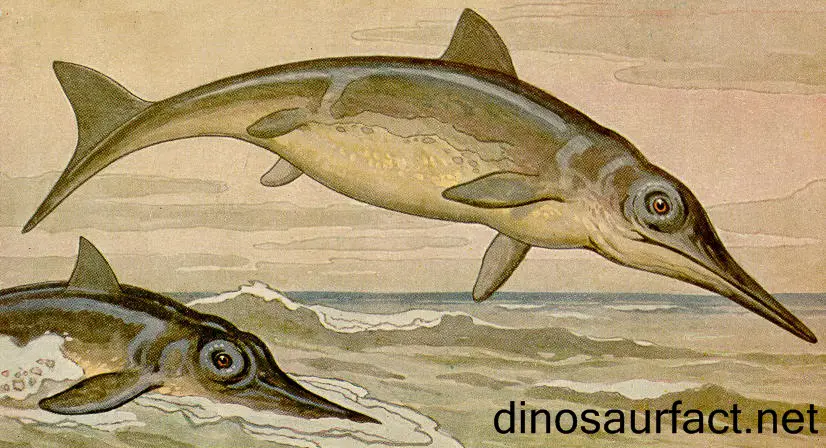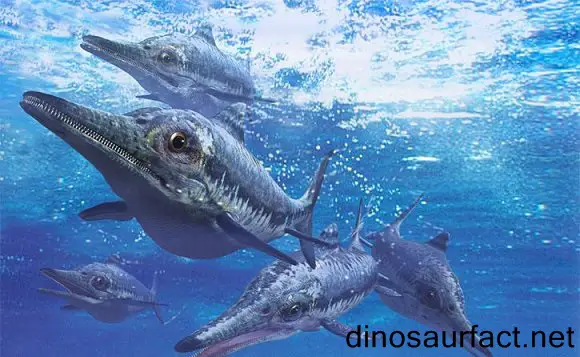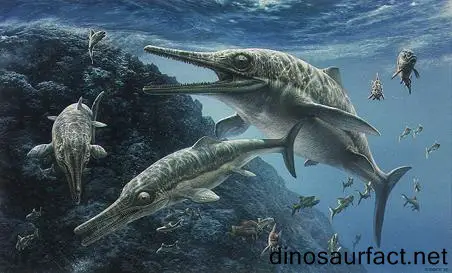



The Ichthyosaurus was a marine vertebrate that existed in the early Jurassic period. The timeline of its existence is estimated at about 190 to 180 million years ago. This lies in the Sinemurian to the Pliensbachian ages of the Jurassic period.
Scientific Classification
Kingdom: Animalia
Phylum: Chordata
Class: Reptilia
SuperOrder: Sauropterygia
Order: Ichthyosauria
Family: Ichthyosauridae
Genus: ichthyosaurus
The Ichthyosaurus belongs to order Ichthyosauria. It is believed to have been evolved from land-dwelling reptiles, similar to other Ichthyosaur species. Its phenotypic appearance was very similar to modern-day fish like sharks but its fossils resembled those of dinosaurs. They were very different from the skeletons of fishes.
The size of the Ichthyosaurus was much smaller than that of other Ichthyosaurids. It grew to an adult length of about 5.8 to 6 feet. Certain Ichthyosaurs achieved body lengths as great as 30 feet.
The Ichthyosaurus was the first Ichthyosaur to be discovered by man. Its remains were uncovered in England in the early 1800s. Scientists believe that it could have been present all over the waters around England and also the Atlantic Ocean.
Etymology
Table of Contents
The name Ichthyosaurus is derived from two words. The prefix ‘Ichthyo’ is derived from the Greek word ‘Icthys’ which translates to ‘fish’. The suffix ‘saurus’ is created from the Greek word ‘sauros’ which means ‘lizard’ in English. Thus ‘Icthyosaurus’ is supposed to denote ‘fish like lizard’.
The nomenclature of the remains of the Ichthyosaurus was done by W. D. Conybeare.
The species name Ichthyosaurus communis has Latin origins and translates to ‘common’ in English.
Classification
- The Ichthyosaurus is classified under order Ichthyosauria and family Ichthyosauridae. As it was the first Ichthyosaur to be discovered, scientists were unsure about its exact taxonomic location. Although the genus Ichthyosaurus was coined as early as 1822, the order Ichthyosauria was described about 20 years later.
- There was no doubt in the minds of biologists that such creatures had evolved from terrestrial reptiles. The bones of the Ichthyosaurus were only slightly modified as compared to those of the Triassic and Jurassic vertebrates.
- Along with the Ichthyosaurus communis, three more subspecies are defined, namely the I. breviceps, I. intermedius and I. conybeari.
Discovery of fossils
Incidentally, the remains of the Ichthyosaurus were discovered by children. Mary Anning and her brother Joseph Anning were playing near the sea shore when Mary spotted bones that looked a little different than those of fish. This happened in the year 1811 in England. Joseph found the skull and Mary found the rest of the skeleton.
These fossils were sold for a small sum to a collector who, in turn, sold them to the British Museum.
Subsequently, many Ichthyosaurus fossils were discovered all over Europe. They were found in many countries including Belgium, Germany and Switzerland. Some fossils were even discovered in Canada and Greenland, which were later attributed to the Ichthyosaurus. This indicates the ubiquitous presence of the Ichthyosaurus across the Atlantic.
Nature of fossils
Complete skeletons of the Ichthyosaurus have been discovered from many parts of England. Certain isolate and disarticulated bones have also been discovered in Europe, which are today ascribed to the Ichthyosaurus.
The total number of fossils attributed to the Ichthyosaurus has been quite large. Due to this, a large amount of data about the Ichthyosaurs has been gathered by paleontologists.
Along with fossilized bones, the Ichthyosaurus is also famous for its fossilized dropping. These fecal samples have provided scientists with a lot of information about the diet of the Ichthyosaurus.
Mary Anning
Mary Anning was possible the first female British geologist.
She was interested in study of fossils and fossil collection since a very young age. She discovered the Ichthyosaurus at the age of twelve. The other fossils discovered by Anning include the Plesiosaurus and the Pterodactylus, among many others.
Despite of her capabilities and acumen, Anning was never taken seriously by the nineteenth-century scientific community due to her gender. She resented this fact, but was never defeated by it and continued her work all her life.
The tongue-twister ‘she sells seashells’ was inspired by Mary Annings.
Physical characteristics
- The Ichthyosaurus externally resembled aquatic vertebrates like dolphins.
- Its length was approximately 1.8 to 1.9 meters. Its weight was estimated to be about 100 kilos.
- Its size was at the lower end of the spectrum as compared to other Ichthyosaurs.
- The fossils discovered in Germany possessed a delineation of the skin as well. This showed that the Ichthyosaurus had a prominent dorsal and caudal fin. These features were common amongst other Ichthyosaurids.
- The Ichthyosaurus had a long jaw. This jaw had serrated teeth.
- The eye sockets and nares were placed very close to each other on the skull of the Ichthyosaurus. It had large inner ear bones as well. This indicated that the Ichthyosaurus had acute sensory organs.
- Its body had a streamlined design.
Habits and habitat
- The Ichthyosaurus was a carnivorous being. This was demonstrated by its jaws and dentition. Furthermore, the fossils of its waste matter contained the remains of fish. This unequivocally determined its feeding habits.
- It preys most likely consisted of smaller fish, squids and shellfish.
- According to the dimensions of its body and fins, the Ichthyosaurus is considered to be a swift swimmer.
- An interesting feature was seen in the fossils of the Ichthyosaurus. The remains of a neonatal specimen were found inside the body of an adult Ichthyosaurus. This indicated that it was viviparous, i.e. it gave birth to live offspring. Such a physiological phenomenon is not seen among other Ichthyosaurs.
- The Ichthyosaurus probably lived in shallow waters. If it resided in deeper waters, so many of its fossils would not have been scattered across the European shores.
Related and coexisting species
The Ichthyosaurus was related to the Stenopterygius.
It is difficult to determine the land ancestors of the Ichthyosaurus. It could have diverged from a number of dinosaurs and archosaurs. But similarities can be seen between the fossils of the Ichthyosaurus and the smaller Jurassic theropods.
The Ichthyosaurus coexisted with other Ichthyosaurs, pliosaurs, crocodilians, rudists and belemnites.
Conclusion
The discovery of the Ichthyosaurus was a momentous one. It was certainly not a dinosaur but its fossils resembled those of dinosaurs. This very clearly displayed that aquatic organisms had terrestrial origins. The viviparous nature of the Ichthyosaurus revealed a lot of information about the origins of water-dwelling mammals. The Ichthyosaurus was a classic example of the evolutionary theory posited by Charles Darwin a few decades after its discovery.
